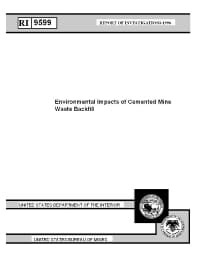Mining Publication: Environmental Impacts of Cemented Mine Waste Backfill
Original creation date: January 1996
Authors: RL Levens, AD Marcy, CM Boldt
NIOSHTIC2 Number: 20023323
U.S. Department of the Interior, Bureau of Mines, Report of Investigations 9599, 1996 Jan:1-22
Researchers at the U. S. Bureau of Mines conducted investigations to evaluate the potential for ground water contamination by mine waste used as backfill. Samples of cemented waste backfill and water discharging from drillholes and seeps were collected to use in chemical analyses and laboratory tests to determine the physical and chemical factors that control release of heavy metals to ground water. Greater water retention by cemented backfill (as compared to uncemented sandfill) reduces the surface area exposed to oxidation, which in turn reduces the amount of acid produced. The acid is neutralized by the cement and minerals contained in the backfill. The grain-size distribution of tailings used for backfill affects the structural integrity of cemented backfill under attack by acidic water; breakdown of the backfill structure releases neutralizing materials faster. Backfilled stopes in rock with low hydraulic conductivities will constitute preferential flow paths after mine flooding; however, the rate of flow through backfill will be much slower than when the stope is partially saturated during mine operation. Considering all factors, acid generation and release of metal ions from cemented backfill should be less than in uncemented sandfill.

NIOSHTIC2 Number: 20023323
U.S. Department of the Interior, Bureau of Mines, Report of Investigations 9599, 1996 Jan:1-22